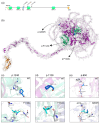Replication of Missense OTOG Gene Variants in a Brazilian Patient with Menière's Disease
- PMID: 40565546
- PMCID: PMC12193698
- DOI: 10.3390/genes16060654
Replication of Missense OTOG Gene Variants in a Brazilian Patient with Menière's Disease
Abstract
Ménière's Disease (MD) is a chronic inner ear disorder defined by recurring episodes of vertigo, fluctuating sensorineural hearing loss, tinnitus, and/or fullness in the ear. Its prevalence varies by region and ethnicity, with scarce epidemiological data in the Brazilian population. Although most MD cases are sporadic, familial MD (FMD) is observed in 5% to 20% of European cases. Through exome sequencing, we have found a rare missense variant in the OTOG gene in a Brazilian individual with MD with probable European ancestry (chr11:17599671C>T), which was previously reported in a Spanish cohort. Two additional rare missense heterozygous OTOG variants were found in the same proband. Splice Site analysis showed that chr11:17599671C>T may lead to substantial changes generating exonic cis regulatory elements, and protein modelling revealed structural changes in the presence of chr11:17599671C>T, chr11:17576581G>C, and chr11:17594108C>T, predicted to highly destabilize the protein structure. The manuscript aims to replicate genes previously reported in a Spanish cohort, and the main finding is that a Brazilian patient with MD also has variants previously reported in familial MD, supporting OTOG as the most frequently mutated gene in MD.
Keywords: Meniere disease; OTOG gene; hearing loss; molecular bioinformatics.
Conflict of interest statement
The authors declare no conflicts of interest.
Figures


Similar articles
-
Systemic pharmacological interventions for Ménière's disease.Cochrane Database Syst Rev. 2023 Feb 23;2(2):CD015171. doi: 10.1002/14651858.CD015171.pub2. Cochrane Database Syst Rev. 2023. PMID: 36827524 Free PMC article.
-
Surgical interventions for Ménière's disease.Cochrane Database Syst Rev. 2023 Feb 24;2(2):CD015249. doi: 10.1002/14651858.CD015249.pub2. Cochrane Database Syst Rev. 2023. PMID: 36825750 Free PMC article.
-
Variants in the KCNE1 or KCNE3 gene and risk of Ménière's disease: A meta-analysis.J Vestib Res. 2016;25(5-6):211-8. doi: 10.3233/VES-160569. J Vestib Res. 2016. PMID: 26890422
-
Pharmacologic and surgical therapies for patients with Meniere's disease: A systematic review and network meta-analysis.PLoS One. 2020 Sep 1;15(9):e0237523. doi: 10.1371/journal.pone.0237523. eCollection 2020. PLoS One. 2020. PMID: 32870918 Free PMC article.
-
Burden of Rare Variants in the OTOG Gene in Familial Meniere's Disease.Ear Hear. 2020 Nov/Dec;41(6):1598-1605. doi: 10.1097/AUD.0000000000000878. Ear Hear. 2020. PMID: 33136635
References
Publication types
MeSH terms
Grants and funding
- 2014/50897-0/Fundação de Amparo à Pesquisa do Estado de São Paulo (FAPESP)
- 141196/2021-1/Conselho Nacional de Desenvolvimento Científico e Tecnológico (CNPq)
- 001/Coordenação de Aperfeiçoamento de Pessoal de Nível Superior (CAPES)
- K7013_B3413/The University of Sydney
- CLINMON2/Asociación Sindrome de Meniere España (ASMES)
LinkOut - more resources
Full Text Sources
Medical

